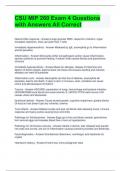CSU MIP 260 Exam 4 Questions
with Answers All Correct
Natural Killer response - Answer-Large granular WBC, respond to infection, organ
transplant rejections, show up faster than T cells
Immediate Hypersensitivity - Answer-Mediated by IgE, eosinophils go to inflammation
and kill parasites
Inflammation - Answer-Monocytes either eat pathogens and/or cause inflammation,
secrete cytokines to promote healing, if doesn't heal causes fibrosis and granulomas
(chronic)
Immediate hypersensitivity - Answer-Basis for allergies, release of histamine and
dilation of blood vessels, plasma leaks into tissue and causes swelling and redness,
allergies can ward off parasites
Inflammation cont - Answer-Neutrophils are first line of defense, eosinophils kill
parasites, lead to cell death, if open to skin or mucous= ulcer, amoebas can cause
ulcers and abcesses(pus formation)
Trauma - Answer-ASCARIS- penetration of lungs, hemorrhage and bacteria infection,
HOOKWORMS suck blood and cause anemia, E. HISTOLYTICA eats mucus of GI
causes ulcers and abscesses
Nutritional deficits - Answer-Cause stunted growth, cognitive impairment, giardia-blocks
GI tract so host doesn't get any nutrients, anemia
Toxic effects - Answer-Malaria-invade and lyse red blood cells releasing toxins, immune
response and lysing cycles causing fever and chills
Pathology for Schistosomes - Answer-Eggs go to liver and block vessels, granulomas
form around eggs and impedes blood flow in liver so hypertension
Pathology for Onchocera volvulus - Answer-Adults in dermis, kids released and wander
into eyes and cornea, are foci of inflammation causing sclerosing keratitis and blindness
Fecal diagnostics - Answer-Gravitational, Baermann, centrifugal, acid fast(looks for
crypto)
Heartworm testing - Answer-Knott's test, immunodiagnotic tests
, ELISA well based test - Answer-Well either had antibody or antigen, substrate attaches
to conjugate and pathogen showing infection
Ecology - Answer-Study of relationships between organisms and environments, focuses
on factors that regulate numbers and distribution of organisms
Host as Environment - Answer-Host is nutrient dense, injests hosts nutrients, parasites
exploit living environments
Abiotic conditions - Answer-Spores, oocyts, eggs, survive the worst conditions (no
nutrients, super hot or cold, acidic)
Transmission Stages - Answer-Adaptations and life, cycles so parasite can survive,
robust immune response
Hosts and Parasite encounter - Answer-Hosts are very dispersed, mostly carnivores to
transfer hosts, target parasites by targeting transmission stages, can improve host
seeking behavior, some more dominant than others when in the same place, ecological
Niches - Answer-Resources and conditions are needed in a specific place, depends on
life stage, GI tract is most popular, can be effected by host, mulitple species can work
together to live if its a weird niche
Adaptations - Answer-Most endoparasites are in GI cause thats where food is, adults
can be anywhere cause of adaptations, preferences based on adaptations and
competition
Quantitative Descriptions - Answer-Intensity= how many parasites in 1 host, Mean
intensity= average number of parasites in a group of hosts, Prevalence= how many
hosts are infected out of larger group of animals
Macroparasites - Answer-Large parasites, don't multiply in host, host is either
uneffected or mildly effected
Acanthocephala - Answer-Spiny-headed worms, rare, no serious disease, can change
shape if parasitic
Acanthocephala body form - Answer-Spiny proboscis, covered in tegument, neck trunk,
cerebral ganlion, metasoma= neck and body
Proboscis - Answer-spiny head, Acanthocephala, hollow, filled with fluid, retracts into
receptacle, ejects from hydraulic pressure, presoma=proboscis and receptacle
Acanthocephala males - Answer-2 testes, bursa, cement glands seals after transfer of
sperm




